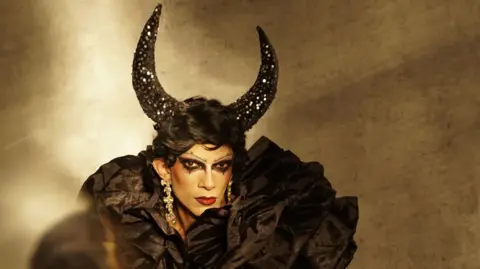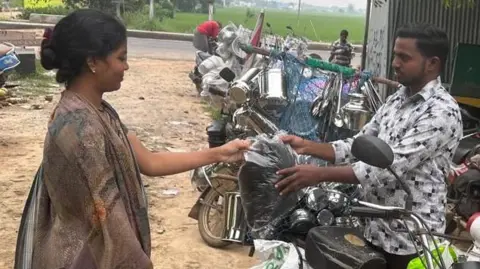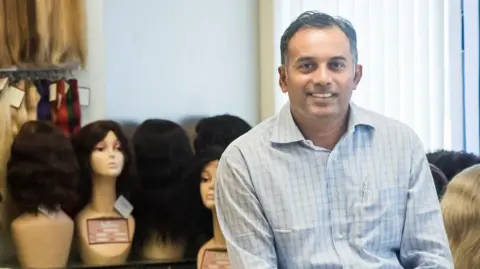Technology reporter, Mumbai
 Reemy
ReemyZeeshan Ali has been an attractive artist for 10 years and has received his appearance throughout India.
Essential for its performance is a collection of about 45 wigs.
“Next to an identity, helping me pass from my daily self to exaggerated, fascinating or miraculous characters. The right wig makes me feel more authentic and empowers me to command the scene,” says Ali, who is located in Mumbai.
But getting the right look was not easy in the early days.
“When I started my career, the possibility of using wig was extremely difficult in India. Most of them had to be taken out of the outside or I made them sourced from everything available to me like wool, fabrics,” he says.
But things are different now.
“The trend is changing. Wigs are no longer intended for attractive artists or film, but many straight women wear wigs to look different. It is no longer just a hair accessory, but a statement of style. “
Indian hair has always been in demand for wig. The nation is the world’s largest exporter of human hair, supplying 85% of global demand.
Kolachi Venca, based in Avad, Chennai, has collected hair for 20 years. He began at the bottom of the industry as a collector – collecting hair from families and saving them from debris.
“My parents were hair collectors and then I started doing the same,” he says.
Hair collected by collectors from homes, salons and barbers are called non-rang hair.
It requires more processing than Remy’s hair, which is carefully shaved directly from the scalp. However, it is worth it.
“It has just been thrown but it’s gold,” says Mr. Vents.
Those collectors usually sell hair local traders like Mr. Vencation for between 10 cents and $ 1 (0.80 £) per kilo, depending on the quality and length of the hair.
Shorter or damaged hair gets less, while longer strands bring higher prices.
For the individual collector, there is not much money in it.
“An zealous collector can collect 1-5 kilograms of hair in a day, earning somewhere from $ 59 to $ 6 a day. This level of income is often below minimum wage standards, especially in rural areas,” Z says . Venice, which has 50 collectors working for it.
“As our work contributes to a global billion dollars market, our profits remain scarce. Mediators control prices.”
 Kolachi
KolachiMost Indian hair collected by traders such as Mr. Venkques is exported to China, where it is done in wigs.
“China has a large wig industry worth five to six billion dollars,” says Benjamin Cherian of Plexconcil, the body of the hair industry that promotes the Indian industry and connects with the government.
If India wants part of the profitable wig market, he says, then she has a lot to do.
“When we look at China, there are hundreds of factories widespread throughout the country that add value to the hair industry, while in India the value increases,” says Mr. Cherian.
He says the government should help promote investment in the hair industry.
“It needs automated classification systems, sophisticated hair treatment procedures for collected hair, innovative production techniques for wig -off production that will make India come to highlight.”
Instead of exporting hair to hundreds of dollars, India must sell thousands of dollars worth Mr. Cherian.
“We’ve started working on it, but it’s a long way to do. We need to have research centers and training,” he says.
 Divine hair diva
Divine hair divaAn Indian business trying to make entry is Delhi-based divine hair, co-founded by Nidhi Tiwari in 2009.
The idea was to create high quality hair extensions and wigs that would appeal to a wider range of customers.
“There is an increasing need for these solutions due to the increase in issues of hair loss and thinning among women in India,” says Ms Tiwari.
The company has been helped by a change of attitude.
“Once it is considered a warm or taboo topic, the wigs and additions are now openly discussed, thanks to the evolution of social norms and a displacement to acceptance,” she says.
Wigs have also seen a lot of development making them more attractive and comfortable.
“Technologies such as 3D printed wigs and color -matching digital tools offer highly personalized opportunities. Lightweight hats, with a hairsp and improved adhesive have given customers to wear it for a long time without embarrassment, “Says Mrs. Tiwari.
 George Cherion
George CherionAt the top end of the hair market is the temple or removed hair.
Much of the supply comes from the Hindu temples in the south of the country where the hair is shaved in an act of reverence and trust.
Raj Hair International is one of the largest traders in the temple hair business.
Chennai factory craftsmen of the company and classify hair by color, structure and length.
“Remy hair has lined the cuticles, hair flowing uniformly in one direction, which leads to less tangling and a softer structure. This is high value hair,” says George Cherion, the company’s chief executive.
The firm tries to spend as little hair as possible. To help with this she developed a car to solve her hair. They are allowed to work faster with less staff.
“Our mission is to constantly improve technology,” says Mr. Cherion.
The business is blooming.
“The Indian man is in demand globally because of his high quality, natural appearance and subtlety. The demand is growing,” he says.
Back to Mumbai Zeeshan Ali wants to see more Indian wigs in the market.
As well as making them more affordable, it has a design suggestion: “a wig that can create a Wow factor.”
